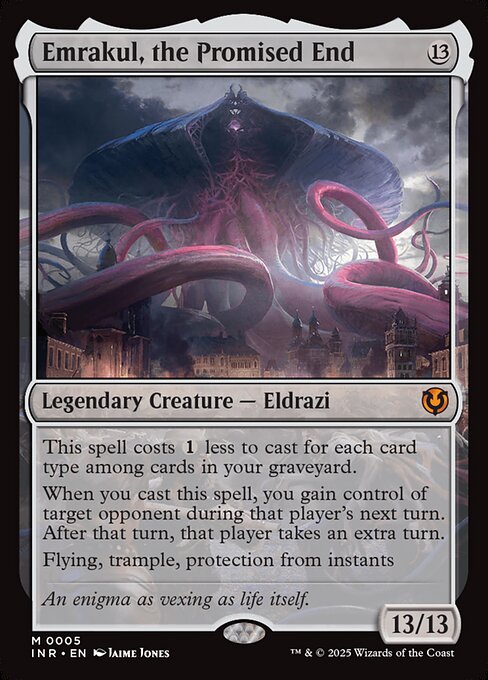
Image courtesy of Scryfall.com
The Psychology of Rarity in MTG: Emrakul’s Enigmatic Allure
Rarity isn’t just a label slapped on a card to satisfy a cataloging system; it’s a social signal, a value proposition, and at times a doorway into a shared fantasy. In the Magic: The Gathering universe, mythic rares loom larger than most cards, not merely because of their ceiling of power, but because of the story they tell about scarcity, achievement, and taste. Emrakul, the Promised End—a legendary Eldrazi from Innistrad Remastered—embodies that aspirational delta in a very tangible way 🧙♂️. Its colossal 13-mana cost, its mythic rarity, and its spellbinding, mind-bending effect collide to craft a moment in a game that players remember long after the board state dissolves into memory dust. This is the psychology of rarity in action, where collectors and players alike trace the emotional arc from “wow, that card exists” to “I must have it, not just for power, but for the story it carries.” 🔥💎
First, consider the aura of mythic rarity itself. In MTG’s hierarchy, mythic rare cards are designed to feel exceptional in both concept and execution. Emrakul’s cost of {13} is a monument to the game’s scale—colorless, massive, and visually imposing. The card’s art and flavor text—“An enigma as vexing as life itself.”—accentuate the feeling that you’re wielding something not just game-changing, but cinematic. The psychology at play is simple but potent: rarity signals a threshold of significance. When a card breaks into mythic status, it invites a narrative around your collection—stories of chase, near-misses, and the rare thrill of owning what feels historically meaningful. 🧙♂️
“An enigma as vexing as life itself.”
Emrakul’s actual gameplay readout deepens that narrative. The spell costs {1} less to cast for each card type among cards in your graveyard. That line nudges players to build diverse graveyards—creatures, artifacts, enchantments, instants, and more—creating a strategic dance between deck construction and resource management. The effect when you cast Emrakul—gaining control of an opponent during that player's next turn, and then the opponent getting an extra turn after—that is not just a board swing; it’s a dramatic turn in the theater of multiplayer games. The drama of mind control in MTG has always captured imaginations, and rarity amplifies that drama: a prank of fate you’re more likely to tell stories about when the card is scarce and coveted. 👀⚔️
From a design perspective, Innistrad Remastered sits in a unique space. It’s a masters set—a reprint-focused line that revisits beloved cards with updated printings. Emrakul’s inclusion in INR reinforces the theme of “reverence and power” that defines mythic staples. The card’s color identity is empty (colorless), and its array of keywords—Flying, Trample, and in particular Protection from instants—delivers a multi-faceted puzzle box. You get the sensation of watching a colossal titan who can ignore most instant-speed answers while threatening to take over the game in spectacular fashion. That dramatic potential underlines why rarity matters: scarcity amplifies the emotional payoff of the most flamboyant, game-altering moments. 💎🎲
Collectors also weigh the cost of entry against the prospect of later payoff. Emrakul, the Promised End exists in both foil and non-foil variants, and its price on Scryfall hovers in the mid-teens USD for nonfoil and a touch higher for foil. In real-world markets, the value isn’t just about raw power; it’s about the memory of the moment you first untapped its power, the sense of joining an exclusive cohort of players who own a defining piece of MTG history. In a world where reprints proliferate and new sets arrive weekly, rarity becomes a compass: it guides where we invest our attention, our decks, and our wallets. 🔥💎
For players who chase the nostalgia and the edge, Emrakul represents a blend of lore and leverage. The Eldrazi titan is emblematic of the broader Eldritch aesthetic of MTG—cosmic, unfathomable, and occasionally disturbingly practical on the battlefield. Pairing Emrakul with graveyard-type strategies can elevate a deck’s personality from “good” to “legendary,” and that leap is part of the magic of rarity: it promises that a single card can rewrite the tone of a match and, to many collectors, rewrite a collection’s narrative arc. 🧙♂️⚔️
As a cross-promotional note, the product link below pairs well with this conversation about tactile, collectible experiences. A high-quality mouse pad—soft polyester, with a sturdy rubber back—becomes more than just a desk accessory; it is a daily reminder of the tactile joy of the game: the touch of a card sleeve, the feel of a well-worn playmat, and the satisfaction of building a dream deck around a mythic centerpiece. If you’re building a space that honors both the mind games and the tactile rituals of MTG, strengthening your setup with dependable gear is part of the ritual. 🎨🧩
Emrakul’s story—and the broader story of rarity in MTG—remains a living conversation. It’s about the chase, the thrill of a scarce gem, and the shared language of players who know that some cards are more than cards—they are cultural milestones within a game that invites us to tell better stories, one match at a time 🔥.
Non-slip Gaming Mouse Pad – Smooth Polyester, Rubber BackMore from our network
- https://blog.rusty-articles.xyz/blog/post/why-wooper-variant-cards-drive-pokemon-tcg-collectors/
- https://blog.digital-vault.xyz/blog/post/disdainful-stroke-reimagined-mtg-fan-art-tributes-to-a-blue-instant/
- https://transparent-paper.shop/blog/post/how-precise-motions-and-parallax-unveil-cluster-memberships-from-field-stars/
- https://blog.digital-vault.xyz/blog/post/path-of-peril-designing-for-player-creativity-in-mtg/
- https://transparent-paper.shop/blog/post/reddened-bp-rp-color-unmasks-a-distant-hot-giant/